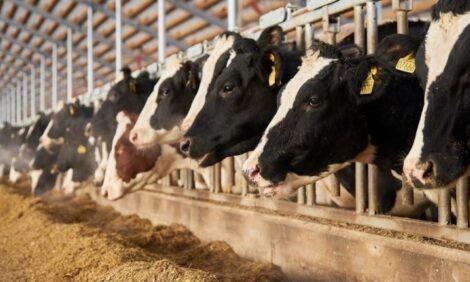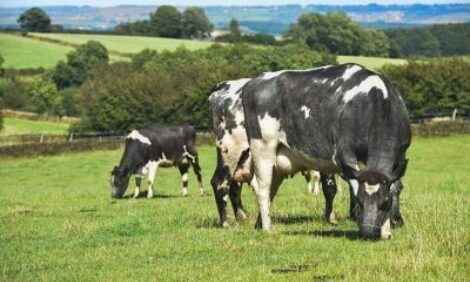



The Role of Calf Nutrition and Management on Lifetime Productivity of Dairy Cattle
Productivity and health starts when the cow is born, not at her first calving, writes Mike Van Amburgh, associate professor in the Department of Animal Science at Cornell University.The effect of nurture is many times greater than nature and the pre-weaning period is a phase of development where the productivity of the calf can be modified to enhance the animal’s genetic potential.
Pre-weaning growth rate explains 22 per cent of the variation in milk yield in first lactation compared to only 7 per cent variation from genetic selection. Anything that detracts from feed intake and pre-weaning growth rate reduces the opportunity for enhanced milk yield as an adult.
The calf goes through significant developmental changes during the pre-weaning period and this development is directly linked to future productivity in first and following lactations. The level of milk yield of an individual cow is affected by both her genetic composition (accounts for 20-30 per cent) as well as her environment (70-80 per cent).
A dairy calf’s environment contains a lot of external factors that can change the way her genetic potential is used. Many of these factors we can control, to help the calf get a good start for a productive life.
Setting pro-active goals and measuring results are keys to a successful calf program. Doubling the birth weight by 56 days should be a minimum goal, i.e. 40 kg birth weight=80 kg at 56 days, calf mortality should be less than 5 per cent and calf morbidity (treatments) should be under 10 per cent. By meeting these goals and focusing on return on investment and lifetime yield instead of only the cost of raising heifers, it will be possible to capture feed efficiency early in life. Age at first calving can potentially be reduced and the potential for milk yield and herd life can be increased.
The Calf’s Maintenance Energy Requirement
The milk replacer most commonly used in the US contains 20:20 in per cent of fat and protein, at the rate of about 1 lb of milk solids per day, which is only good enough to keep the calves alive, just about maintenance level. Calves less than 40 days of age are comfortable between 15 to 27°C. A 50 kg calf requires ~7.5 MJ ME (1.8 Mcal) per day for maintenance in thermo-neutral conditions.
The additional heat increment required to maintain core body temperature below 15°C (59 °F) is approximately 0.092 MJ/kg0.75/°C, especially for calves less than 40 days old. Mike Van Amburgh reported that 90 per cent of the dairy farmers he had asked usually fed calves the same in January as in July, although the energy requirements are dramatically different. At either end of the 15-27°C it is necessary to make adjustments; abate heat or feed more, to allow them to generate heat so they can continue to grow when it is cold. It is necessary to provide 2 to 3 times the maintenance requirements to achieve reasonable growth objectives after accounting for seasonal effects.
The Magic of Colostrum
To maximize calf survival and growth, plasma immunoglobulin (Ig) status and thus colostrum management is of utmost importance. Until recently, the primary reason colostrum has been of interest in neonatal ruminants is due to the importance of supplying Ig’s. Without sufficient levels of Ig’s, morbidity and mortality rates are increased. While Ig’s are important, colostrum provides the newborn calf with other components as well, such as insulin, IGF-I, relaxin and other growth factors and hormones. These might be important factors in developmental processes, and a lack or shortage of them in early life might alter developmental functions, leading to a change in nutrient utilization and efficiency. Relaxin, for instance, has shown to stimulate uterus development and improves reproductive efficiency.
Will a Calf Make More Milk if You Feed it Better?
To answer this question a review and an analysis of available data sets were made, looking at journal papers, abstracts and proceedings. And the answer was yes. Calves that received more nutrients from milk or milk replacer prior to weaning were estimated to produce 429 ± 106 kg more milk in first lactation compared to control calves.
These results were further supported by an analysis on data from the Cornell herd of 1,244 heifers which showed that every kg of average daily gain (ADG) prior to weaning resulted in a milk yield increase of over 2,200 kg milk over 3 lactations. Further, 22 per cent of the variation in first lactation milk production could be explained by growth rate prior to weaning.
Calves that were fed 4 liters of colostrum 2 hours after birth and another 2 liters 10 hours after birth were compared to calves that were only fed 2 liters of colostrum 2 hours after birth. After the initial colostrum feeding both groups had free access to milk replacer. The calves that were fed 4+2 liters of colostrum in their first day of life demonstrated an 8.5 per cent increase in milk replacer intake, an 18 per cent increase in pre-weaning ADG, a 12 per cent increase in post-weaning feed intake, and a 25 per cent increase in post-weaning ADG through 80 days of life compared to the other group. This indicates that colostrum has the potential to affect appetite regulation, which enhances growth and possibly feed efficiency.
Growth Rate Shows Large Variation on Milk Yield
The primary trait that is most commonly genetically selected for is milk production. The effect of growth rate and nutrient intake prior to weaning had a more direct and significant effect on milk yield than genetic selection for production. Selection on milk production accounts for 7 per cent variation, whereas calf growth accounts for 22 per cent variation, three times more. Genetic selection yields ~ 68 – 115 kg milk per lactation, whereas pre-weaning calf nutrition and management can yield 4 to 8 times more milk per lactation.
Illness and Productivity
Studies from Cornell also show that calves with diarrhea had reduced growth by 30gr/day. Calves that had diarrhea and received antibiotics had an ADG that was approximately 50 g/day lower. Calves without a recorded treatment produced 1,407 kg additional milk per kg ADG. Calves with a recorded treatment produced 623 kg additional milk per kg ADG. This implies that sickness causes calves to reduce intake, which reduces growth and takes time to recover and leads to loss of productivity of approximately 780 kg.
Does Intensive Heifer Rearing Pay Off?
A comparison between conventional and intensive heifer rearing showed that extra feed costs amounted to $65.25, but savings on labor, health/vet med costs, interest, reproductive culls, other costs and total ‘dead calf’ costs amounted to a total of $117. By adding the value of additional milk during first lactation of $180, the advantage for Intensive Heifer Rearing was ~ $231 per cow.
Key Messages
• The pre-weaning period is a period of life where the calf is undergoing significant developmental changes and this development is directly linked to future productivity in the first and subsequent lactations.
• Pre-weaning growth rate and primarily protein accretion appears to be a key factor in signaling the tissue or communication process that enhances life-time milk yield.
• Anything that detracts from feed intake and subsequent pre-weaning growth rate reduces the opportunity for enhanced milk yield as an adult.
• Nutrient supply, both energy and protein are important and protein quality and digestibility are essential.
• There are no substitutes for liquid feed prior to weaning that will enhance the effect on long-term productivity.
• Factors other than immunoglobulins in colostrum modify feed intake, feed efficiency and growth of calves and can enhance the effect of early life nutrient status.
• As an industry and as nutritionists we need to talk about metabolizable energy and protein intake and status relative to maintenance and stop talking about liters, kilograms and grams of dry matter, milk, milk replacer etc. The calf has discrete nutrient requirements not related to dry matter and liquid volume measurements.
• The effect of nurture is many times greater than nature and the pre-weaning period is a phase of development where the productivity of the calf can be modified to enhance the animal’s genetic potential.


